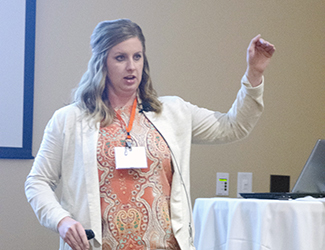Evaluating PAP as a Genetic Prediction Tool
Angus Genetics Inc. pooled multiple data sets to develop an EPD for PAP evaluations.
by Kaci Foraker, editorial intern
BROOKINGS, S.D. (June 19, 2019) — Kelli Retallick, genetic service director of Angus Genetics Inc. (AGI), updated attendees at the Beef Improvement Federation symposium on her recent and continuing work to develop a production expected progeny difference (EPD) for yearling high-altitude pulmonary arterial pressure (PAP).

Kelli Retallick on PAP in efficiency and adaptability committee
The large correlation (0.83) between PAP scores taken at moderate and high elevations allows geneticists to start thinking about how to fit the two different traits into a two-trait model to predict high- elevation PAP, reported Kelli Retallick, AGI genetic service director. [Photo by Kaci Foraker]
AGI staff started collecting PAP scores in 2013 and began a collaborative research effort with Colorado State University (CSU) in 2016, said Retallick. Their goal was to answer three questions: Is there a relationship and value in taking PAP measurements at lower elevations? Does PAP have a relationship with growth traits? Is PAP affected by varying carcass traits?
Retallick referenced a recent study published by Rachel Pauling, CSU, analyzing Angus cattle. The first main outcome from the study was determining high altitudes from moderate altitudes.
“Rachel analyzed all of our PAP data together in one analysis and came up with 147 distinct elevation locations,” said Retallick. When analyzing these varying locations, Pauling found that when elevation reached 1,620 meters, or roughly 5,250 feet, PAP started to increase as a result of the increased elevation.
Once high- and moderate-altitude levels were designated, correlations between the two levels were analyzed. Heritability was 0.30 and 0.29 for high elevation and moderate elevation, respectively, said Retallick. This result was similar to past projects with PAP, but the most important aspect was the 0.83 correlation between the two different elevations.
“There is a very large positive correlation,” said Retallick. “That basically allows us to start thinking about how we fit these two different traits in a two-trait model that would allow us to capture the variation that we are collecting at these moderate elevations and use them to predict high-elevation PAP. We actually have a higher correlation using moderate-elevation PAP as a predictor than we do using ultrasound measurement to predict carcass traits.”
However, when growth traits were analyzed alongside PAP, there was no strong correlation found. She said there is no direct finding that the industry’s increasing weaning weights and yearling weights are causing PAP issues.
Since the release of a research EPD in February, AGI has added about 3,000 weaning PAP records to its database. After incorporating and working with these additional records, AGI hopes to release a production PAP EPD by the end of 2019, said Retallick.
Retallick acknowledged that this type of EPD is “not a replacement for an actual PAP score.” She stated in an example an Illinois bull with the best PAP EPD should not be expected to always survive in a hypoxic environment at high altitudes.
“However, being able to identify that Illinois bull as a prominent sire through artificial insemination, that’s a great opportunity,” said Retallick. “There is definitely progress that can be made and allow our high-altitude breeders to identify animals that pose less risk.”
The 2019 BIF Annual Convention was hosted by South Dakota State University and the South Dakota Beef Breeds Council June 18-21 at the University Comfort Suites and Convention Center in Bookings. ANGUS MEDIA® provides comprehensive online coverage of the event at www.BIFconference.com. Visit the Newsroom for summaries, proceedings, PowerPoints, video and/or audio of the sessions and the Awards page for announcements and photos of award winners.
Editor’s Note: This summary was written under contract or by staff of ANGUS MEDIA®. Through an agreement with the Beef Improvement Federation,
we encourage reprinting of the articles to those who will adhere to the
reprint guidelines available on this site. Please review those
guidelines or contact Shauna Rose Hermel,
editor, at 816-383-5270. PowerPoints are posted with permission of the
presenter and may not be reproduced in whole or in part without the
express permission of the presenter. We welcome educational venues and
cattlemen to link to this site as a service to their audience.
For questions about this site, or to notify us of broken links, click here. Look for additional coverage in the Angus Journal, the Angus Beef Bulletin, the Angus Journal Daily, the Angus Beef Bulletin EXTRA and Angus TV.


